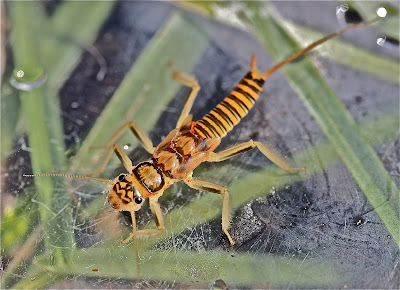Monday, May 14, 2012
Correcting a Mistake Made Last Year: It Was Isogenoides hansoni, not genus Yugus
On March 25th of last year -- 2011 -- I posted a report of some beautiful insects I had found at the Rapidan River in which I identified the stonefly pictured above as a Perlodid, genus Yugus. That ID wasn't correct: this is a fairly mature Perlodid stonefly, but Isogenoides hansoni.
Regular readers may recall that I found a small Isogenoides hansoni nymph at the Rapidan River in September -- 9/12/11 to be exact. This one (which I did ID correctly!):
On 10/21, I found one that was a bit more mature.
All winter long, I've been hoping to find a mature nymph, not knowing that I had found one last year that was preserved in my reference collection! And it was a beauty, even though one of its tails had broken off.
How I arrived at an ID of Yugus last year I no longer remember. But let's correct that now by working through Steven Beaty's description of the genus Isogenoides, and then the species hansoni.
"Genus diagnosis: Lacinia triangular, bidentate with a distinct knob below the subapical tooth and with a row of marginal hairs approaching base; mesosternum with median longitudinal suture joining fork of mesosternal grooves to transverse anterior suture; prominent submental gills, projecting about three times their basal width; cerci with a dorsal setal fringe; body light brown with contrasting darker brown pattern, covered with clothing hairs." ("The Plecoptera on North Carolina," p. 22) Note: the key features are in italics.
1) The photo below shows that the lacinia is indeed "bidentate," with a knob below the subapical tooth.
The "marginal" hairs are difficult to see in this photo -- but they're there; I was unable to get a photo at a good angle.
2) The mesosternum -- showing the median and anterior sutures.
Since the anterior suture/ridge is not very clear in this photo, let's look at a photo of another I. hansoni nymph that I collected.
3) Prominent, long submental gills. For sure.
The joining of the sutures in the mesosternum along with the prominent submental gills are the key features in confirming an Isogenoides ID. (See Peckarsky, Freshwater Macroinvertebrates, p. 71.) Let's return to Beaty on the question of species ID.
"I. hansoni -- nymphs 16-24 mm; large denticles on the ventral mandibular tooth; conspicuous, sharply delineated M-shaped pale mark anterior to median ocellus; ocellar triangle bordered by dark but with pale central spot; dark transverse bands on anterior third of half of terga 1-9 and a dark, transverse band along each posterior margin. Relatively rare."
I haven't looked at the mandibular tooth. As for the rest -- the pale M anterior to the median ocellus is clear in all of our photos, as is the dark ocellar triangle with the "pale central spot." But for emphasis...
And here's a close-up of the abdomen showing and the dark transverse bands at the top and bottom of each of the tergites.
_____________
So there you have it. As an amateur I do make mistakes, but when I recognize them I always try to correct them.
Subscribe to:
Post Comments (Atom)











No comments:
Post a Comment